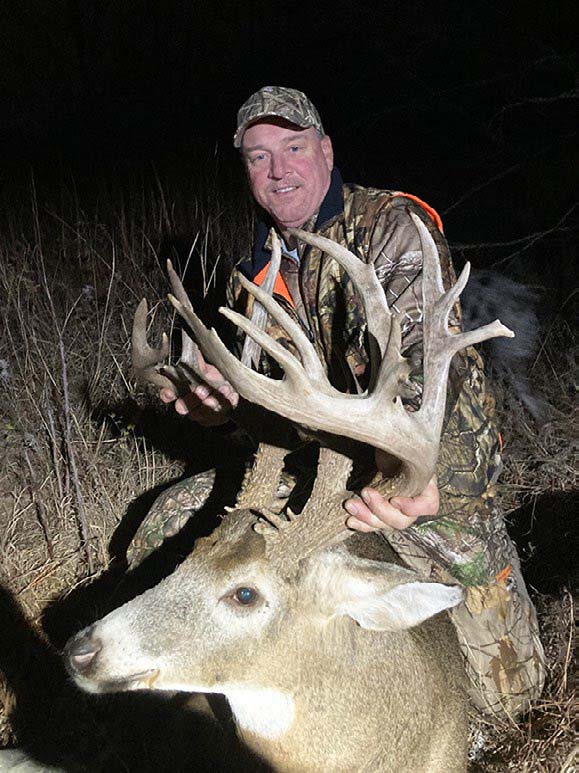Darin Hess shot the deer of 10,000 lifetimes on a permission property
- Buck Score: 250 inches (gross) / 237 5/8 inches (net)
- Date of Harvest: November 15, 2021
- Location of Harvest: Riley County, Kansas
- Weapon of Harvest: Mathews bow
Kansas deer hunter Darin Hess knows Whitetails, and his quest for a huge deer ended during the 2021-22 season. But it started the year before, albeit briefly. “I first saw this deer in the fall of 2020,” Hess said. “One time and that was it. I started getting trail cam pics of him around the first of October in 2021.”
By this point, he thought the buck was likely 5½ years old, and it was straight green lights. This buck was without a doubt on the shoot list. Having hunted the area since 2019, and knowing how deer use it throughout fall and winter, he had a decent idea of where to intercept this buck.
On November 13, he started hanging a stand in a promising stand location, but deer started moving while working on it, so he backed out. He returned the next day, on November 14, to finish it.
On November 15, 2021, his plan came to fruition. The day brought sunny skies and 70-degree highs, which isn’t what you anticipate for a November rut hunt. Still, it’s the rut, and deer do what deer do. Hess wasn’t missing an opportunity at this buck because of elevated temps.
His stand location was positioned in a fence line between a pastured area and a winter wheat field. The winter wheat sprawled out in front and to the left. Timber and pasture was to the right. Around 3 p.m., after leaving work early, he settled into his hunting spot. “As I was climbing to my stand, a doe and a six-point buck came out into the field,” he said. “The doe headed south and the six-point came right by me and went north out of sight.”
Once in the stand, he started watching the fence line and pasture area. Eventually, about an hour later, he heard something behind him. He slowly peeked around the tree but didn’t see anything. He turned back around, and the huge Whitetail was in the field about 150 yards away.
After a few tense seconds, the deer stopped and drank water in a terrace channel. “While he was drinking, I caught movement out of the corner of my eye to the left,” Hess said. “It was another doe, and she stopped at 20 yards.” The buck spotted the doe and walked toward her rather quickly.
Fortunately, the deer worked within bow range. Hess took a deep breath, drew back, settled in, and took the broadside, 30-yard shot. The arrow blew through the vitals, and the deer bolted for cover.
“I hit him a little back, and as he spun, I saw blood all down the backside of him,” Hess said. “He ran 60 yards and laid down. I watched him for about 30 minutes, and he did not move from that spot. I got down and called some buddies and we waited two hours before going back to recover him. He did not move from that spot.”
Three friends, Kyle Cook, Justin Bolt and Bryce Mongeau, helped with the recovery and loading the deer. Looking back, Hess attributes a lot of the success to scouting by trail camera and staying out of the area as much as possible.
“[There aren’t] many out there like him,” Hess said. “The hunt could not have worked out any better. It was like he read the script. Some people said it was well-deserved and some said I was lucky. I just have great landowners that allow me to hunt their property.”
That’s certainly true, as a permission property relinquished a 250-inch Kansas Whitetail. It doesn’t get any better than that.
Outdoor Lab: Big Buck Tactics
Hess first learned of this deer from an in-the-field encounter. He saw it during the 2020 deer season. Then, in 2021, he started getting trail camera photos of the massive Whitetail. Scouting played a role in learning the buck’s core area.
In mid-November, during the peak of the rut, he moved in to hang a treestand in a promising location. This spot was in a fencerow in an area with a lot of edge habitat. There were also some crops, timber, and pasture ground in the area. His location was an area where deer commonly converged, also known as a pinch point. A water source was nearby, too, which also played a role. Furthermore, he was able to use part of the open field as a void where minimal deer activity occurred, and his scent could blow out into it with less risk of deer catching wind. Having these zones decreases the likelihood of being detected by deer.

